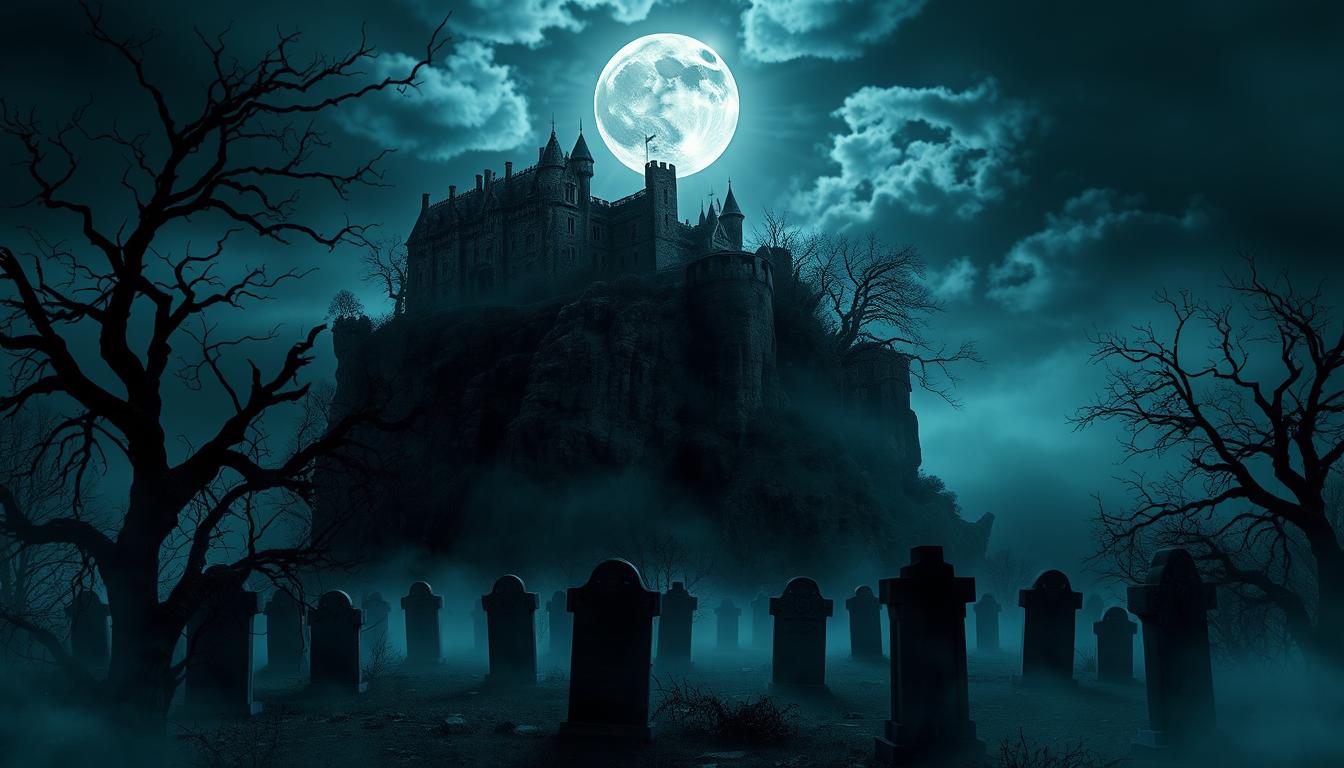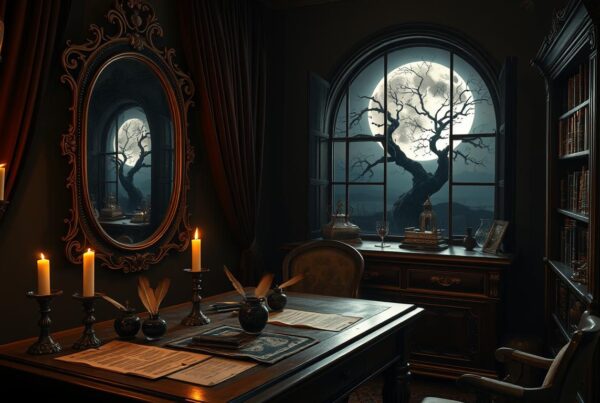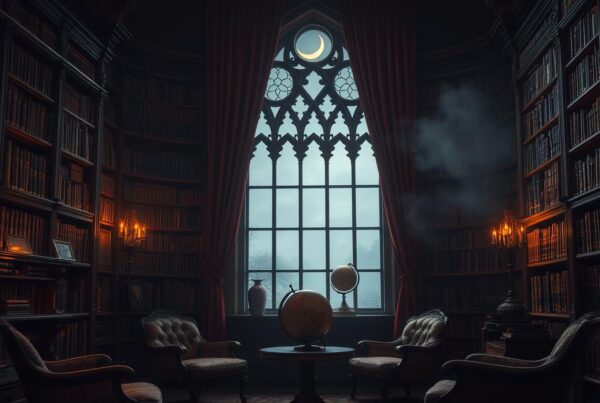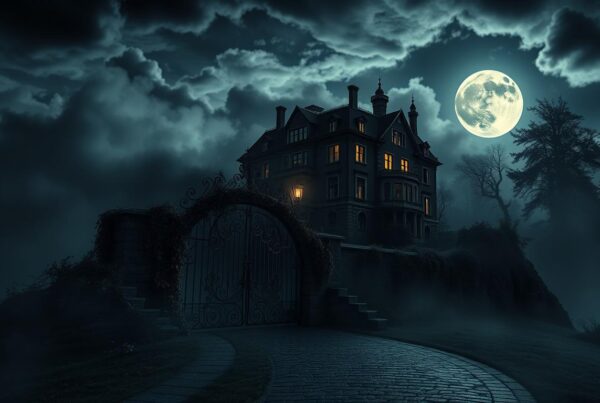Gothic literature has been a hit for centuries. It mixes love stories with spooky settings and supernatural stuff. This makes for a special reading experience.
Gothic romance takes us to places like old castles and mysterious forests. These stories have complex characters facing their inner fears and outside dangers. It’s all about exploring human feelings through mystery and suspense.
Let’s dive into Gothic literature and find out what makes it so popular. We’ll look at the themes that have made it a favorite among readers. Get ready to explore the dark side and see why dark romance is so captivating.
The Origins of Gothic Romance Literature
Gothic novels started in the late 18th century. They mixed romance and horror. This genre came out during big changes in Europe, showing the era’s fears and interests.
Historical Context and Influences
The Gothic romance genre was born from a love for medieval buildings and the supernatural. It was influenced by Romantic ideas, Gothic art, and ghost stories.
Key Pioneers of the Genre
Horace Walpole wrote the first Gothic novel, “The Castle of Otranto,” in 1764. It paved the way for more Gothic stories. Ann Radcliffe made the genre famous with her novels that mixed romance and fear. Mary Shelley’s “Frankenstein” added to the genre, exploring the dark side of science.
Evolution of Gothic Romance
The Gothic romance genre has changed over time. It started with haunted castles and supernatural events. Now, it includes psychological horror and social comments. Today, Gothic themes are still seen in books, movies, and culture, showing its lasting charm.
Dark and Foreboding Settings in Gothic Romance
Gothic castles are key in Gothic romance. They are more than just places. They hold secrets and set the mood. Their tall spires and dark halls fill the air with mystery and fear.
Haunted mansions are also big in Gothic stories. These old homes, now in ruin, spark our imagination. The sounds of creaking floors and candles flickering add to the tension.
The decay of these mansions shows the characters’ inner states. It’s like their homes reflect their minds.
Gloomy landscapes are also important. Places like misty moors and dense forests make characters feel trapped. These wild places show the characters’ inner struggles. They also set the stage for spooky events and deep love stories.
The mix of dark settings and emotions is what Gothic romance is all about. As the story goes on, the feeling of fear grows. Gothic castles, haunted mansions, and dark landscapes all come together. They make a world where love and fear are mixed, keeping us eager to find out what happens next.
The Archetypal Gothic Hero and Heroine
Gothic romance novels grab our attention with their unique characters. These stories have complex heroes and heroines who drive the plot. Let’s dive into the iconic figures that make Gothic romance so engaging.
Characteristics of the Brooding Hero
The Byronic hero is a key figure in Gothic literature. He’s mysterious, passionate, and has inner turmoil. His dark past and struggles with demons make him complex.
This complexity draws readers in, making them want to learn more about him.
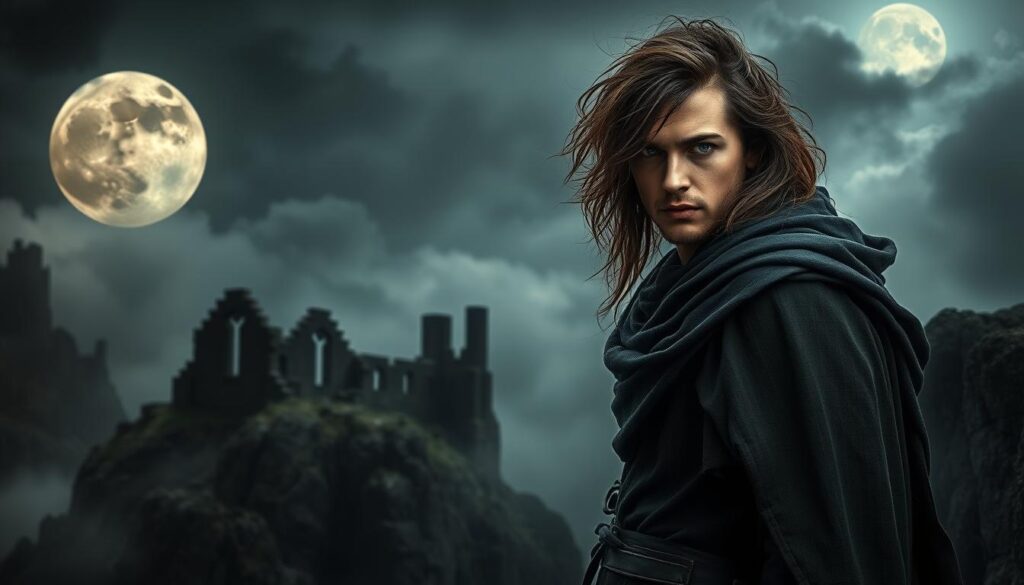
The Vulnerable Yet Strong Heroine
Gothic heroines are not damsels in distress. They show courage and strength in danger and mystery. They are both vulnerable and strong, making them relatable.
These women face peril but use their wit and resilience to get through it.
Character Development and Transformation
Both heroes and heroines change a lot in the story. The brooding hero might find redemption through love. The heroine discovers her inner strength.
This change adds emotional depth to Gothic romance. It keeps readers hooked on the characters’ growth.
The mix of these archetypes creates the thrilling tension of Gothic romance. As readers, we’re pulled into their world, eager to see their stories unfold.
Supernatural Elements and Their Significance
Gothic romance novels are full of eerie feelings and scary stories. They have supernatural parts that make us shiver. Ghosts, curses, and strange events are key to the mystery and fear.
Ghosts are like messengers from the past. They show hidden truths or seek justice. These spirits can mean unresolved issues or the heavy burden of history on characters. They also push characters to face their biggest fears.
Curses add mystery to Gothic romances. They come from old family fights, forbidden love, or dark secrets. Characters must find out where these curses come from and break free. This journey often leads to personal change and redemption.
Paranormal events in Gothic stories include strange noises and moving objects. These happenings make the atmosphere creepy. They make characters doubt their sanity and add depth to the story.
Authors use ghosts, curses, and strange events to explore big themes. They look at good vs. evil, the past’s power, and the human mind’s mysteries. These elements help dive into characters’ deepest fears and wishes, making Gothic romance a fascinating genre.
The Role of Mystery and Suspense
Gothic suspense keeps readers on edge. Writers use clever ways to build tension and create unforgettable plot twists. These methods make the genre known for its unease.
Building Tension Through Plot Devices
Gothic authors use many plot devices to increase suspense. They might add unexplained noises or mysterious figures in shadows. These spark curiosity and fear, making readers want to keep reading.
The Unreliable Narrator Technique
Unreliable narrators add mystery to Gothic tales. These storytellers might be delusional, dishonest, or confused. Their views keep readers guessing, adding to the mystery.
Foreshadowing and Dramatic Irony
Foreshadowing hints at future events, creating a sense of doom. Dramatic irony happens when readers know something characters don’t. Both build anticipation and fear, key to Gothic suspense. Writers use these elements to create complex stories that grab audiences.
Symbolism and Themes Common in Gothic Romance Literature
Gothic romance literature is full of symbols and themes. These elements weave a rich tapestry of meaning. They pull readers into dark, atmospheric worlds.
Dark castles and haunted houses are common in Gothic tales. They symbolize the human mind, with hidden passageways showing the unconscious. Stormy weather mirrors characters’ emotions, while fog and mist add mystery.
Forbidden love is a big theme in Gothic romance. It taps into readers’ desires for passion. The battle between good and evil is also key, often shown in characters’ inner struggles.
Locked rooms, family curses, and ancient prophecies are common motifs. They add suspense and intrigue. Gothic authors use these symbols and themes to create unforgettable stories that still captivate today.
Exploring the Theme of Forbidden Love
Gothic romance tells stories of doomed love. These tales capture our hearts with passionate stories of star-crossed lovers. They face love against society’s rules, creating tension that moves the story along.
Writers like Emily Brontë and Charlotte Brontë are experts at this. They create unforgettable couples who go against what’s expected.
In “Wuthering Heights,” Heathcliff and Catherine’s love crosses class lines but ends in tragedy. Their story shows how society can break even the strongest love. Jane Eyre and Mr. Rochester also face big challenges, like secrets and moral choices.
These stories of forbidden love touch us deeply. They speak to our desires and fears. The fight against society’s rules makes characters more real, leading to heart-wrenching choices.
Through forbidden love, Gothic authors make us think about society and true love. These stories have stayed popular for years, showing the lasting appeal of star-crossed lovers.
The Struggle Between Good and Evil
Gothic romance loves the fight between light and dark. Characters face tough choices, leading to big decisions. This battle is key in many famous stories.
Internal Conflicts of Characters
Gothic villains are hard to pin down. They fight with themselves, torn between good and bad. This makes them both scary and interesting.
External Manifestations of Moral Dilemmas
Characters’ inner battles show in their actions. Gothic romance shows how choices affect the world. Haunted places and storms reflect their inner fights, making stories richer.
Redemption and Damnation
Many Gothic tales focus on redemption or damnation. Characters hit key moments that decide their future. This keeps readers hooked until the end. The quest for salvation or the fall into darkness is a classic theme.
Gothic Architecture as a Metaphor
Gothic architecture is key in Gothic romance stories. It sets the mood with its tall spires, dark halls, and secret rooms. These elements symbolize the turmoil inside characters and the story’s themes.
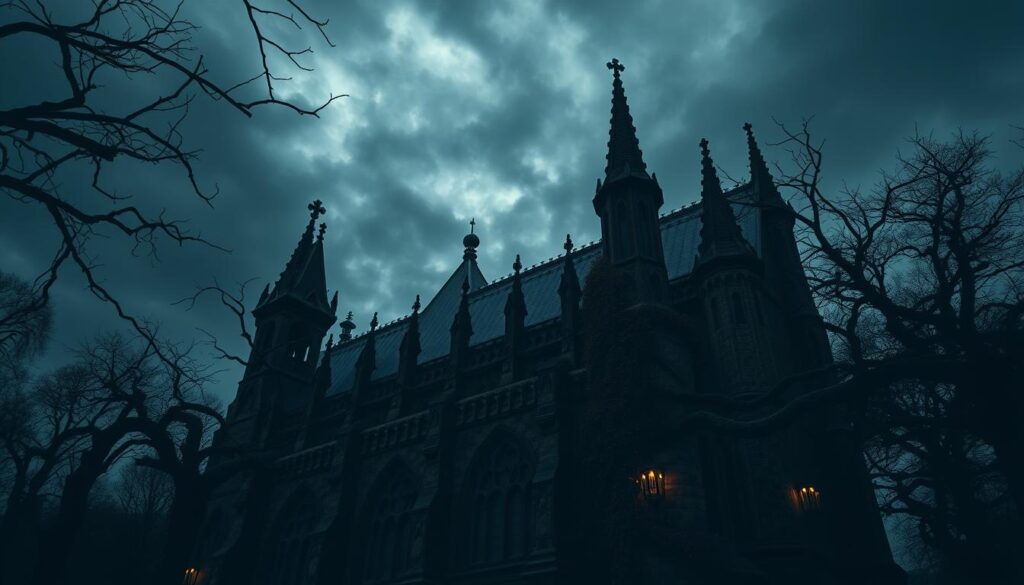
Labyrinthine structures are big in Gothic novels. They show the complex feelings of characters. Winding stairs and maze-like paths reflect the twists in characters’ minds as they face their fears and desires.
Hidden passages are also important in Gothic romance. They stand for the hidden parts of us and the secrets we keep. These secret paths add mystery to the story, making it more exciting.
The decay in Gothic architecture symbolizes the end of old ways and the start of new ones. Old castles and mansions show the decline of the past. They also hint at the secrets and sins hidden within. This symbolism enriches the themes of change and redemption in Gothic romance.
The Influence of Nature and Weather
Gothic romance writers use nature and weather to set the mood. They mirror characters’ emotions with this technique, called pathetic fallacy. It creates a strong connection between the story’s atmosphere and its characters’ inner worlds.
Storms as Emotional Mirrors
Thunderstorms often reflect characters’ turmoil in Gothic novels. Lightning flashes and booming thunder signal moments of revelation or danger. Emily Brontë’s “Wuthering Heights” uses wild storms to echo Heathcliff’s passionate outbursts.
This shows how natural symbolism enhances the narrative.
Landscapes Reflecting Inner Turmoil
Desolate moors, craggy cliffs, and gloomy forests serve as backdrops in Gothic romances. These landscapes mirror characters’ isolation and inner struggles. The fog-shrouded streets in Bram Stoker’s “Dracula” create an eerie atmosphere.
This adds to the sense of mystery and dread.
Seasons and Their Symbolic Meanings
Seasons play a crucial role in Gothic literature. Winter often symbolizes death or isolation, while spring represents rebirth or hope. In Mary Shelley’s “Frankenstein,” the harsh Arctic setting reflects Victor Frankenstein’s cold ambition and the monster’s isolation.
By using atmospheric conditions skillfully, Gothic authors deepen their stories’ emotional impact.
